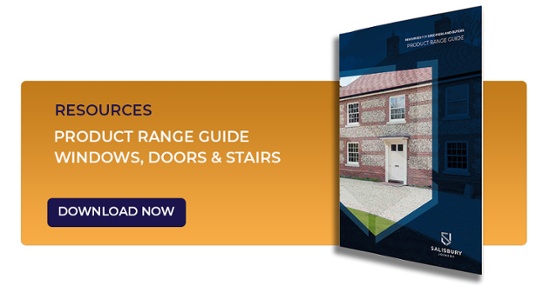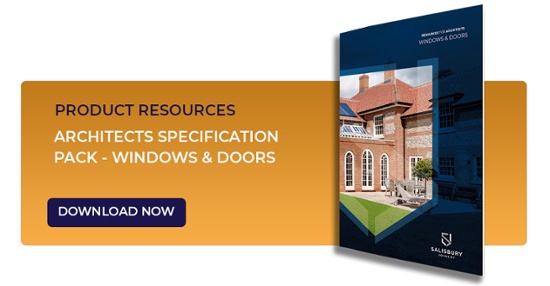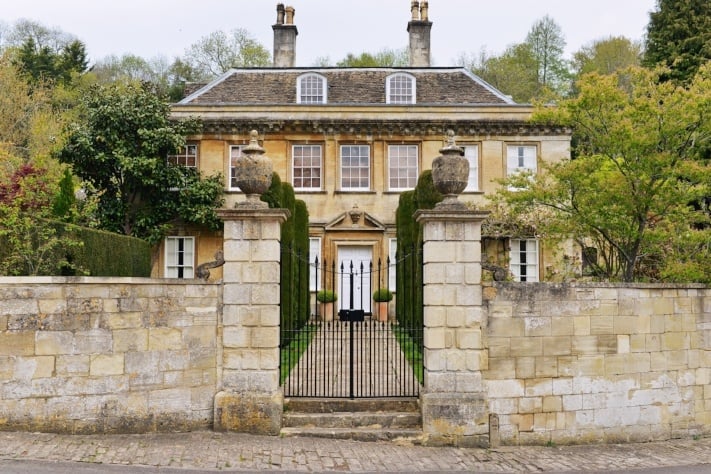
One of the most recognisable and iconic styles in interior design, which has stood the test of time and continues to prove as popular today as it ever was, is the box sash window.
From large country estates to traditional city dwellings, the sash window offers a timeless elegance that can capture a sense of heritage for any property.
What are sash windows?
A sash window is formed of two or more sliding glazed frames, referred to as ‘sashes’, which together in an outer frame creates a box sash window.
One of the most recognisable features of this type of window is its striking visual design, which sees multiple rows of matching glass panes, held between bars within the sash that are positioned in box frames which are then set back behind the external masonry.
The style of window is thought to have first emerged in Great Britain in the 17th century (although this has been the cause of some debate) and they have remained a popular choice ever since, being well suited to large traditional-style properties in either country or city locations.
Over the years, the design, style and functionality of sash windows has evolved, along with the many options that now exist for their decoration and personalisation.
The history of sash windows
The Great Fire of London, which took place in September 1666, was a catalyst for UK property and window design. Up until that point, buildings had been densely packed together and the use of timber framing was common.
After the fire, which devastated a staggering 80% of the capital, building regulations were strengthened in an attempt to prevent fire from spreading so easily in the future. These regulations continued to be expanded upon as the years went by and many are still keeping the capital safe today.
They include the rule that buildings must only be built from brick or stone and that doors and windows should be recessed at least four inches from the front of the building.
By the 18th century, most cities had similar regulations in place and the sash window style had become something of a fashion trend. Especially as this type of window could be seen in use in prestigious buildings, such as Kensington Palace and Hampton Court Palace.
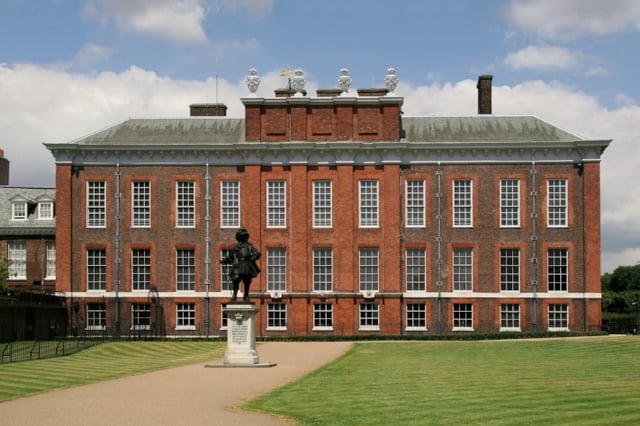 Kensington Palace, London
Kensington Palace, London
Sash windows also offered greater functionality compared to what had been before, with the option to open them aiding ventilation.
 Hampton Court Palace
Hampton Court Palace
Georgian architecture
Around this period, glass production was improving. This saw the creation of larger panes of glass and the emergence of the familiar ‘six panes over six panes’ that is most often associated with Georgian-style sash windows.
Victorian architecture
By the mid-19th century, glass production had improved even further. This saw larger panes being used, a popular development as it allowed more light to penetrate a room. The Victorian era also brought with it more ornate and elaborate design features, such as the surrounds, brickwork and trims.
Edwardian architecture
By Edwardian times, sash windows commonly combined an upper sash made of multiple panes of glass, with a single pane lower sash. While the overall formation was far simpler than it had been previously, one decorative feature to emerge around this time was the use of stained glass in upper sashes.
Modern day sash windows
The two main types of sash windows around today are:
Traditional box sash windows
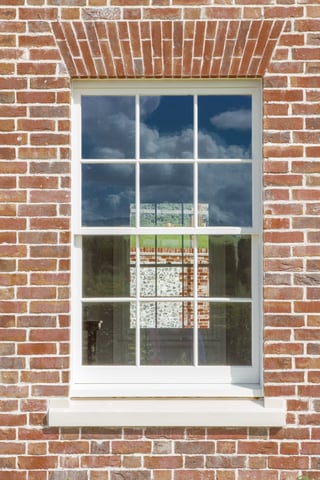
This type of window is ideal for both large traditional properties and conservation projects.
It uses the method of cords, weights and pulleys to counter balance the sashes, with the weights discreetly hidden in a box each side. The dimensions of the box typically being 85 x 175mm.
Historically, box sash windows would be set back, so that the box would be hidden by the external brick or stone, however in recent decades they have been positioned between the brickwork, with the box on show and finished externally with a timber mould.
Spring balance sash windows
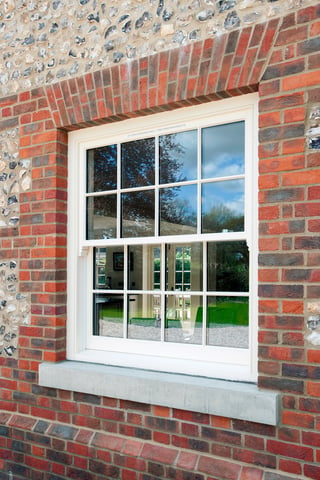
Spring balance sash windows offer a modern alternative to the weight-based system. They are most suited to developments which are free of conservation constraints, but where a stylish, traditional appearance is desired.
The spring-loaded mechanisms are situated on each side of the sashes. One key advantage is that the springs are far more compact than weights, meaning boxes are not required each side.
Personalised sash windows
There are several ways that the design of a sash window can now be tailored. This includes:
Spray finish
A water-based spray colour finish can be applied to the frame, the most sustainable choice being an environmentally friendly solution that allows the timber to flex and breathe naturally. The primer coat offers added protection, through the inclusion of a knot inhibitor and tannin stop.
The typical lifespan of a spray finish up to first maintenance will be seven years for opaque paints and four years for translucent paint. However, many factors can influence durability, for example exposure if it’s a costal site, or equally if it’s in a very sunny location. Regular maintenance is encouraged to ensure your joinery can be enjoyed for decades to come.
Glass
Decorative glass can be used, for example in situations where visibility needs to be reduced and toughened glass can be used in critical locations.
Aside from the aesthetic aspect, there are other issues that should also be taken into consideration when it comes to glazing. They include security, energy efficiency (ability to keep warmth in and cold out, such as through the inclusion of draft excluders, and the use of units with a low U value and effectiveness as a sound barrier to external noise.
Sash furniture (ironmongery)
From stainless steel to chrome and brass, there are many options when it comes to sash window furniture. Box sash windows typically have sash lifts, sash fasteners to lock the sashes in place and for added security lockable sash stops; and when weights are used sash pulleys.
Some of the most popular finishes are: Polished Chrome, Satin Chrome, Polished Stainless Steel, Satin Stainless Steel, Polished Brass, Antique Brass and Black.
For more help on choosing the right windows for your project, download our Free Architect's Specification Pack with readymade technical and specification drawings.
Other issues to consider
Product warranties
The quality of the window should mean they are enjoyed by generations to come. Product Warranties can offer extra peace of mind here. They should be applicable in respect of the joinery, finish and glazing.
Part Q
The approved document Q, which came into effect on the 1st October 2015, makes it mandatory for windows and door sets to be manufactured to a design that has been proved by test to meet the security requirements of PAS 24:2012. Anyone who requires planning permission to build a new residential dwelling needs to comply, as well as commercial or agricultural buildings being renovated or refurbished into a residential dwelling. For more information visit www.planningportal.gov.uk
CE Marked
Windows for domestic or commercial applications use need to be CE Marked, confirming they conform to BS EN14351-1:2006+A1:2010.
CMS Mark
The CMS (Compliance Management System) mark covers timber windows and doors manufactured in hardwood and softwood. It was devised by CEN Solutions Ltd – one of the UK’s largest supplier of quality certification working in the Insulated Glass & Window Industry, and are one of only three certification bodies recognised by The NHBC.
For more information and advice on the construction, use and installation of box sash windows, call us on 01722 337040
You may also like to look at our Product and Specification Guide which contains detailed information about sash windows.
Alternatively our Window overiew outlining different types of windows is informative, along with our Resource book.
Related Posts
Large PAS24 Sash Windows Fully Certified
Following stringent independent tests, Salisbury Joinery, is believed to offer the largest...
Sash Windows Certified to Latest PAS24 Security Standard
Salisbury Joinery's PAS24 Sash Windows have been tested and certified to the latest PAS24:2016...
Higher Window performance of Box Sash Windows
Salisbury Joinery is proud to report that its high-performance Box Sash Window has achieved an even...


